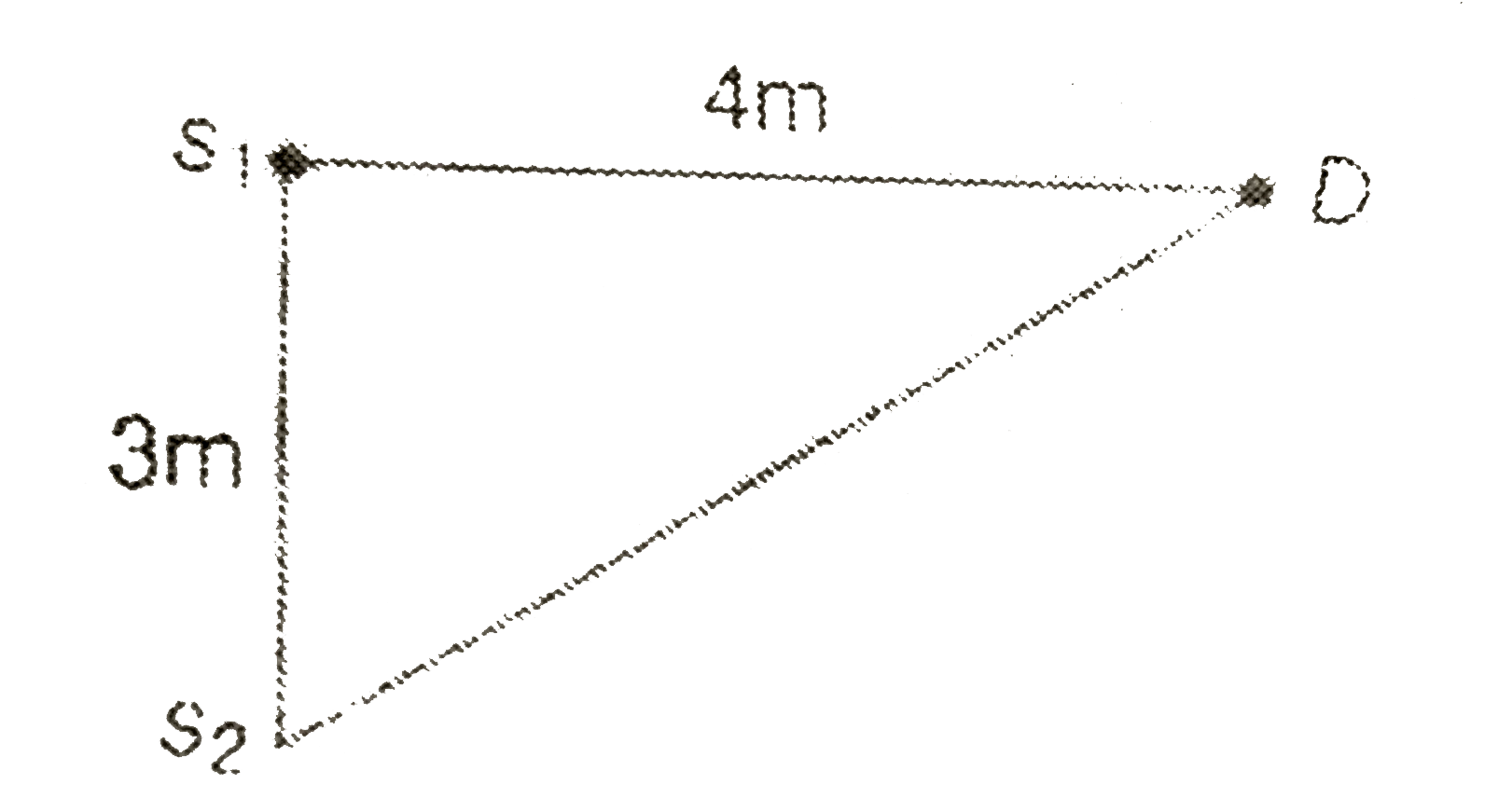_S01_032_Q01.png)
Figure shows two coherent microwave source S1 and S2 emitting waves of wavelength λ and separated by a distance 3λ for λ<<D and y≠0. The minimum value of y for point P to be an intensity maximum is √mDn determine the value of m+n, if m and n are coprime numbers.Solution in Gujrati
The correct Answer is:7
_S01_032_S01.png)
Path differrence =3λcosθ=2λ⇒cosθ=23
y=Dtanθ=D√52⇒m+n=5+2=7
Topper's Solved these Questions
- WAVE OPTICSBOOK - ALLEN CHAPTER - WAVE OPTICSEXERCISE - Example 15
1 Videos
- WAVE OPTICSBOOK - ALLEN CHAPTER - WAVE OPTICSEXERCISE - Exercise 1 (Check your Grasp)
75 Videos
- WAVE OPTICSBOOK - ALLEN CHAPTER - WAVE OPTICSEXERCISE - Example 13
1 Videos
- UNIT & DIMENSIONS, BASIC MATHS AND VECTOR BOOK - ALLEN CHAPTER - UNIT & DIMENSIONS, BASIC MATHS AND VECTOR EXERCISE - Exercise (J-A)
7 Videos
Similar Questions
_S01_033_Q01.png)
In a typical young's double slit experiment a point source of monochromatic light is kept as shown in the figure. If the source is given an instantaneous velocity v=1 mm per second towards the screen, then the instantaneous velocity of central maxima is given as α×10−βcm/s upward in scientific notation find the value of α+β
View SolutionWhich of following phenomenon is not to explained by Huygen's construction of wavefront?
View SolutionStatement-1: In Young's double slit experiment the two slits are at distance d apart. Interference pattern is observed on a screen at distance D from the slits. At a poit on the screen when it is directly opposite to one of the slits, a dard fringe is observed then the wavelength of wave is proportional of square of distance of two slits.
Statement-2: In Young's double slit experiment, for identical slits, the intensity of a dark fringe is zero.
View SolutionMatch List I with List II and select the correct answer using the codes given below the lists :

View SolutionIf in an A.P.S_(n)=n^(2)p and S_(m)=m^(2)p, then S_(p) is equal to
View SolutionA line divides an equilateral triangle ABC of side 1 unit into two parts with same perimeter and different are S_(1) and S_(2) sq. units. If maximum value of (S_(1))/(S_(2))=m/n (where m and n coprime), then |m-n| is _____
View SolutionIn the figure , the intensity of waves arriving at D from two coherent soucrces s1ands2isI0. The wavelength of the wave is λ=4m . Resultant intensity at D will be

View SolutionConsider two coherent monochromatic (wavelength lambda ) sources S_(1) and S_(2) separated by a distance d. The ratio of intensity of S_(1) and that of S_(2) at point P is 4. The distance of P from S_(1) if the resultant intensity at point P is equal to (9)/(4) , times the intensity due to S_(1) is : (n is a positive integer )
View SolutionIf Sm=m2pandSn=n2p, where m≠n in an AP then prove that Sp=P3
View Solutionयदि Sn=n2p तथा Sm=m2p,m≠n है तो सिद्ध कीजिए कि Sp=p3
View Solutionदो कला - सम्बन्ध स्त्रोत S1 तथा S2 एक ही कला में तरंगदैर्घ्य λ की प्रकाश तरंगे उत्पन्न करते है तथा उनके बीच की दूरी 2λ है S2 से गुजरती और S1S2 पर लंबरेखा के बिंदुओं पर विचार करे | S2 से वह न्यूनतम दूरी निकाले जहाँ तीव्रता न्यूनतम हो ।
View Solutionकिसी समान्तर श्रेणी में Sn=n2P तथा Sm=m2P,m≠n तब SP=
View SolutionConsider two coherent, monochromatic (wavelength lambda ) sources S_(1) and S_(2) , separated by a distance d. The ratio of intensities of S_(1) and that of S_(2) (which is responsible for interference at point P, where detector is located) is 4. The distance of point P from S_(1) is (if the resultant intensity at point P is equal to (9)/(4) times of intensity of S_(1) ) ("Given : "angleS_(2)S_(1)P=90^(@), d gt0 and n" is a positive integer")
View SolutionTwo coherent point sources S_(1) and S_(2) vibrating in phase emit light of wavelength lambda .The separation between the sources is 2 lambda .The smallest distance from S_(2) on a line passing through S_(2) and perpendicular to S_(1)S_(2) where a minimum intensity occurs is :
View SolutionTwo coherent point sources S1 and S2 are separated by a small distance 'd' as shown. The fringes obtained on the screen will be :
View SolutionFor as Ap. Sn=mandSm=n . Prove that Sm+n=−(m+n).(m≠n)
View Solution
